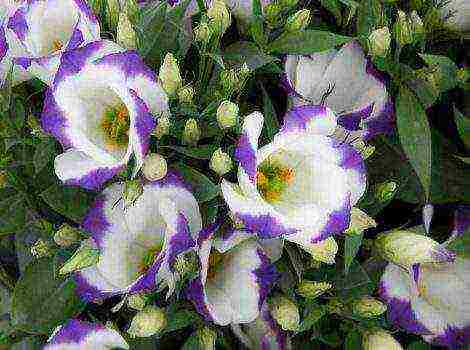Content
- 1 Preparing the bulbs
- 2 How to prepare soil and containers?
- 3 How to grow?
- 4 Growing in water
- 5 Care features
- 6 Growing in a greenhouse
- 7 Growing in hydroponics
- 8 Growing in sawdust
- 9 Growing from seeds
- 10 Which variety should you choose?
- 11 What types of onions can be grown on a windowsill?
- 12 Instructions for growing onions on a windowsill
- 13 How to care for onions after planting - advice from gardeners
- 14 Growing onions in water - the original way
- 15 Smart solutions
- 16 Growing a feather from an old bulb
- 17 Growing green onions "hydroponically"
- 18 Green onions from bulbs in soil
- 19 Growing a feather from onion sets
- 20 Pickling and warming up the set
- 21 Preparation of soil and containers
- 22 Planting seeding in the ground
- 23 Planting care
Onions are a wonderful vegetable crop with many beneficial properties. For the preparation of delicious dishes, not only the bulbs themselves are useful, but also the green feather. In addition, you can grow healthy spicy onion greens all year round on your own windowsill. We will learn how to grow onions on a feather at home: how to plant a crop correctly, how to care for it.
Preparing the bulbs
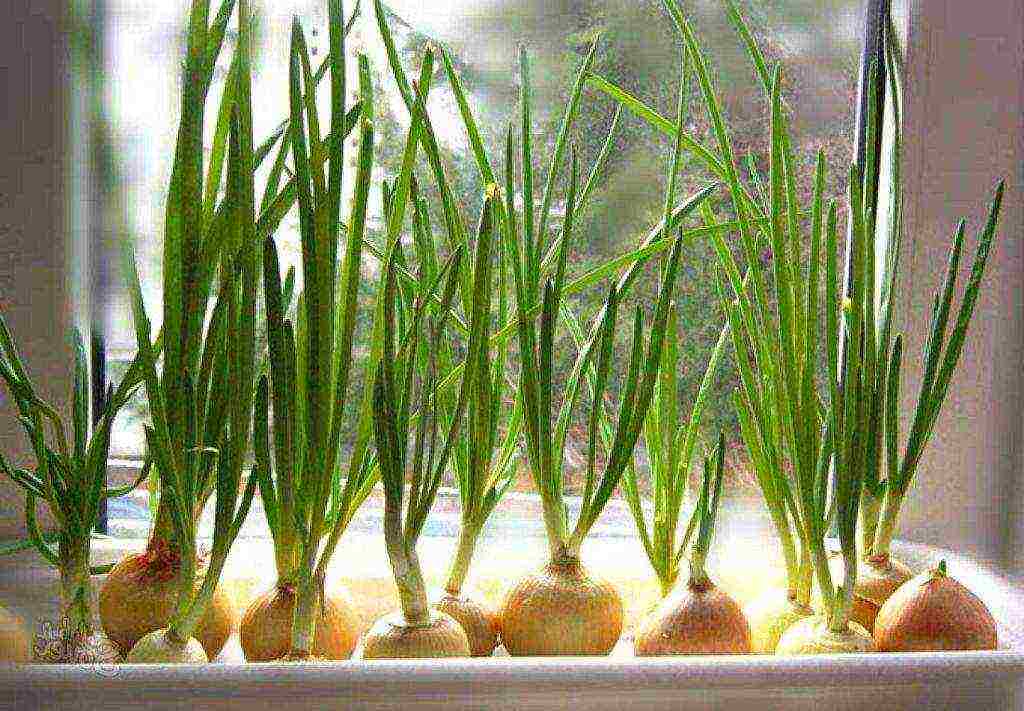
For the forcing of the green onion feathers to be successful, the bulbs must be properly prepared before planting. How exactly to do this - we will find out further.
Mother bulbs are the planting material for onion feathers - ordinary onions are most often used. Keep in mind that to get a feather, it is better to take medium-sized onions - they produce greens the fastest, and quite plentiful. The best specimens for this purpose are onions with a diameter of 3-4 cm and a weight of 40-50 grams.
Sort the planting material: peel the onions, remove defective specimens, weak, diseased and damaged. The bulbs that you plan to plant should be completely healthy, with a shiny skin: dry and free from rot.
Place before planting the bulbs in a solution of potassium permanganate or saline. Such processing will ensure the disinfection of the planting material.
To grow onions without the danger of infection with peronospora, it is recommended to warm up the planting material at a temperature of +40 degrees for eight hours.
Attention: if you are going to grow a feather for sale, choose onions of the same size - then the greens will turn out to be uniform, ripen at the same time.
To make the feather hatch faster, cut off the top of each onion by one quarter of the total. This measure will provide oxygen access to the kidneys, and the greens will appear much faster.
It was found that with preliminary cutting of the tops of the onions, the yield of greens will be 80% higher. But if you planted the onions, forgetting to cut off the tops, then you do not need to cut off the already rooted heads - on the bulbs that have taken root, this, on the contrary, will slow down the distillation of the feather.
A measure that will also help the greens hatch faster is to soak the onions in warm water overnight just before planting. Cutting off the tops should be done after this procedure.
As for the planting time, usually planting is carried out in winter at the end or at the beginning of spring - in order to enjoy the vitamin first greens before summer. With greenhouse cultivation, onions are usually planted on a feather in late autumn.
How to prepare soil and containers?
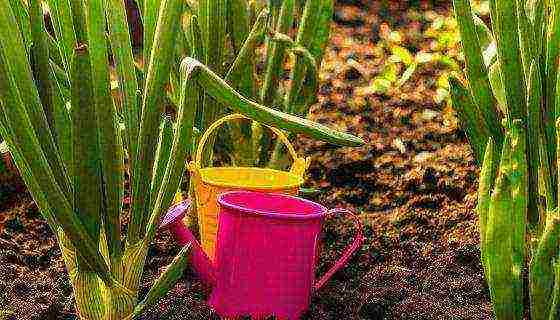
In order for the onion feather to turn out to be lush, bright and fragrant, saturated with nutrients, the culture must grow in fertile soil. It is important to provide the onion with a loose, light, air and permeable soil.
It is recommended to prepare the following earthen mixture:
- turf;
- humus;
- peat land.
All ingredients are taken in approximately equal proportions. Be sure to add superphosphate and sodium chloride to the resulting mixture. Superphosphate is added at the rate of 30 grams of fertilizer per 1m2 of soil, chloride - 15 grams per the same volume.
Pre-wash the containers intended for onion sprouting and treat with a disinfectant.
How to grow?
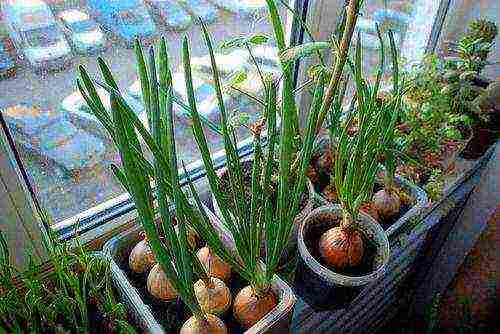
Let's take a closer look at the whole process of growing onions for greens.
As mentioned above, before planting, the onions are disinfected, then kept in warm water at night and the tops are cut off to speed up the forcing process.
The container should be taken low - a container with a height of 8-12 cm is fine. It is best to plant in a standard "bridge" way - the bulbs are placed very close to each other, almost closely.
Do not make the distance between the onions more than one to two centimeters. To grow about 1m2 of nutritious and healthy greenery, you will need 10 kg of planting material. If you want to grow a green feather for the needs of your family, keep in mind that for three people it is enough to plant 5-6 onions.
The planting material is buried insignificantly into the ground. It is necessary to lightly press the bulbs into the soil - about 2-3 cm. Some gardeners, in principle, do not press the bulbs for fear of damaging the roots, but simply put them on the ground on top and sprinkle them on the sides.
Immediately after placing the onions in the soil, they must be watered abundantly. This measure will start the rooting process. Move the container to a warm place (+ 25-30 degrees) - at a warm temperature, the forcing process goes faster. After about a week, the length of the feathers will already reach 1.5-3 cm - and then the containers can be transferred to a cooler room.
The optimum temperature for growing onion feathers is from +18 to +22 degrees.
Attention: do not place containers of onions in close proximity to batteries or other heat sources. This can lead to too rapid drying of the soil, evaporation of water. In addition, the feather grows poorly with constant overheating.
Growing in water

At home, it is very convenient to forcing an onion feather in the water. The method eliminates contact with the ground, which ensures cleanliness on the windowsill, the absence of dirt, the need to water the plants. You can use anything from a faceted glass to a plastic or metal container.
In order for onions to give strong roots in water, a pallet is needed, deeper than with traditional, "land" cultivation.
The landing in this case is as follows:
- prepared onions are tightly placed in the pallet;
- fill the planting material with water by one quarter.
When growing a feather in water, the container should stand on the windowsill in order to receive sufficient light. In two weeks, the first greens will appear. But it is necessary to monitor the water level in the sump and add it.
It is important that the roots are not exposed - otherwise the onion will dry out and you will not see the green harvest. Change the water completely periodically to prevent the smell of putrefaction.
Important: do not pour too much water into the pan, as the constantly weeping onion pulp can rot.
Care features

Key points of care for feather onions.
Watering
A very important procedure in this case. The home growing method involves regular watering of the onions - at least once or twice a week. It is better to use warm water so that the feather grows faster and fungal infections do not appear.
Do not overdo it with watering, as the bulbs can easily rot in warm and humid conditions. And a few days before harvesting the feathers, watering should be stopped altogether - the process of pruning and cleaning the greens will be easier.
Top dressing
It is not necessary to add additional nutrition to the soil with onions during the growing process.Before planting, fertilizers are applied - and they are quite enough for the production of green feathers.
However, if fertilizers were not applied before planting or there were few of them, you can feed the onions - but not more often than 2-3 times during the entire growing season. It is best to use ammonium nitrate as a nutrient (40 grams of substance per 10 liters of water). Fertilizer is applied during watering.
If you plan to cut several feathers, you can feed the onions after each harvest. Top dressing will give the plant the strength to form new greens from the bulb.
Loosening
An important procedure. It is advisable to carry it out after each watering, but not immediately, but after a couple of days, when a crust begins to appear on the surface. Loosening makes the soil light, permeable, which is very important for onions.
Airing
The procedure is relevant for greenhouse onions. At home, the indoor temperature is unlikely to rise to tropical conditions.
Pests and diseases
Green onions are usually grown without chemicals. Therefore, in this case, it is more rational and correct to prevent diseases and pests than to fight them later. So that the onion does not get sick, it is important to comply with all the conditions for its cultivation and care, and also not to forget to decontaminate it before planting.
Cleaning
The feather is usually cut when it reaches a length of 30-35 cm. You can either cut the feather, leaving the bulbs for further growing greenery, or dig up the planting material with roots completely.
Growing in a greenhouse

We will learn how to grow a green onion feather in a greenhouse.
For planting, in this case, one-year or two-year-old onions are selected. Planting is usually done in the fall. The planting method is the same as at home - pavement.
The soil mixture for the greenhouse is taken as follows:
- sod land;
- humus (or old manure);
- peat;
- compost and ash as fertilizers.
It is recommended to sprinkle the prepared soil with fluffy lime on top to prevent mold on the ground.
So, the onions are planted in late autumn - by the bridge method, with a distance of 2-3 cm between them.
It is important to maintain an optimal temperature regime inside the greenhouse so that the feather appears faster. During the day, the temperature should be from +18 to +20 degrees, and at night it can drop to + 12-15 degrees. When the feather reaches about 5-8 cm (after one and a half to two weeks), the temperature is added to + 20-22 degrees in the daytime.
Important: if you grow onions in a greenhouse at a high temperature (above +22 degrees), the feather will grow quickly, but in the end it will turn out to be too elongated, not too marketable.
As for the care of greenhouse onions, it includes the following mandatory procedures:
- watering;
- loosening the soil;
- airing the greenhouse;
- top dressing.
It is also important to provide the greenery with sufficient light - onions will not grow well in a dark greenhouse.
Growing in hydroponics
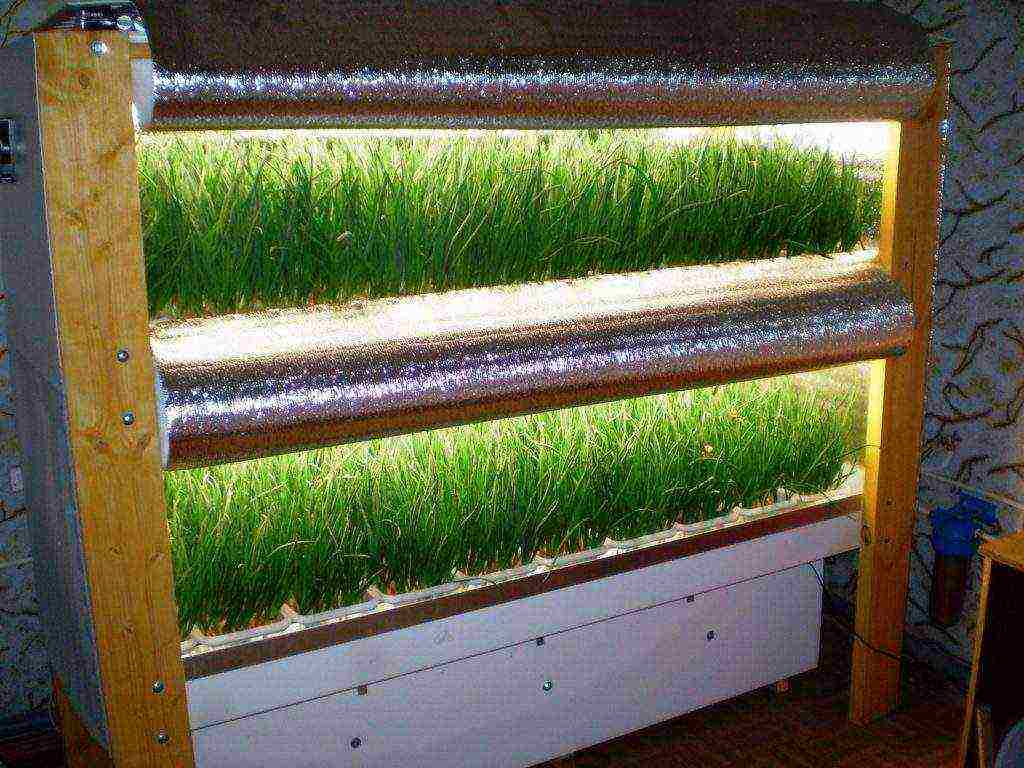
The point of the method is to grow crops in oxygen and nutrient rich water. It is also a very real home method of cultivating green onions - and very modern, without soil and dirt.
The purchase of a hydroponic plant costs money, however, in terms of convenience, no other method can be compared with this method. And usually all the costs of buying a hydroponic plant when growing onions for sale pay off in the very first season.
To grow onions hydroponically, you need to purchase special mats (plates). Usually, this method is used when they plan to grow greens for sale, and not exclusively for their own table. A business using hydroponic technology will allow you to produce fresh greens all year round, sell them and make good profits.
In hydroponics, the feather grows very quickly - you can cut it two weeks after planting. Planting is carried out in a special liquid substrate: the first week the onion grows in the shade, the second - in the light.It is important that in this case, only the roots are lowered into the liquid, and the very bottom of the onion does not come into contact with it. Thus, rotting of the bulbs does not occur.
Growing in sawdust
There is also such a way of forcing an onion feather at home. Moreover, the method gives excellent results, moreover, it is very economical. We recommend purchasing sawdust from a pet store (where they are sold as filler for rodent cages).
It is necessary to prepare containers in advance: any will do - from special containers to plastic packaging from cakes or pastries. The container is filled with sawdust (clean and disinfected), the layer should be 2-3 cm.
Important: to quickly disinfect sawdust, pour boiling water over them for half an hour before placing them in a container. After cooling, the sawdust will turn into a loose, slightly slimy substrate, quite ready for growing onions.
The bulbs are laid out in the traditional way. A container with sawdust can be placed on a windowsill, balcony or loggia - the main thing is that the place is well lit and warm. And after a couple of weeks, you can harvest fresh herbs.
When grown on sawdust, onions need to be watered from time to time, but there is no need to feed. Add 3% hydrogen peroxide (10 ml per 1 Liter of water) to the water for irrigation. The substance will help the onions not to rot. After the harvest is collected, the sawdust is thrown away - they are not reused.
Growing from seeds

At home, feather onions can also be grown from seeds - however, this method is irrational and too long. Therefore, for this purpose, it is practically not used.
The feather harvest will be in only three months, and the amount of greens itself will be much less than when grown from ready-made onion bulbs. That is, there is more fuss and trouble, and the result is much less.
Briefly the process for the most patient:
- take small, wide containers, place a thin layer of drainage on the bottom and a standard potting mix on top;
- seeds should be planted in the ground to a depth of 1-1.5 cm, water;
- wrap the container with foil, put it in a warm and bright place (on the windowsill, for example);
- when shoots appear, remove the film;
- water the soil regularly, without letting it dry out. And three months after planting, it will be possible to harvest the feather.
Which variety should you choose?
Among the modern variety of varieties and types of onions, it is not surprising to get confused. We will find out which varieties of onions are best grown for greens at home.
Onion

This species is sometimes also called Tatar or winter. Very productive, the greens are bright, uniform and beautiful. To obtain a high-quality feather, it is recommended to use perennial varieties of batun - so you can harvest not one, but several full-fledged crops per season.
Leek
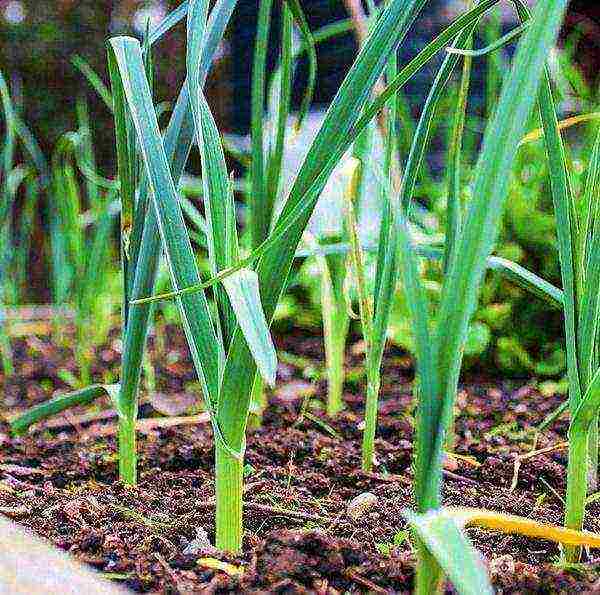
The variety is also called pearl, it has a very pleasant taste. The feather is similar to the feather of garlic, but it is much larger in size. A productive and profitable variety, it shows itself well when cultivated at home.
Slime
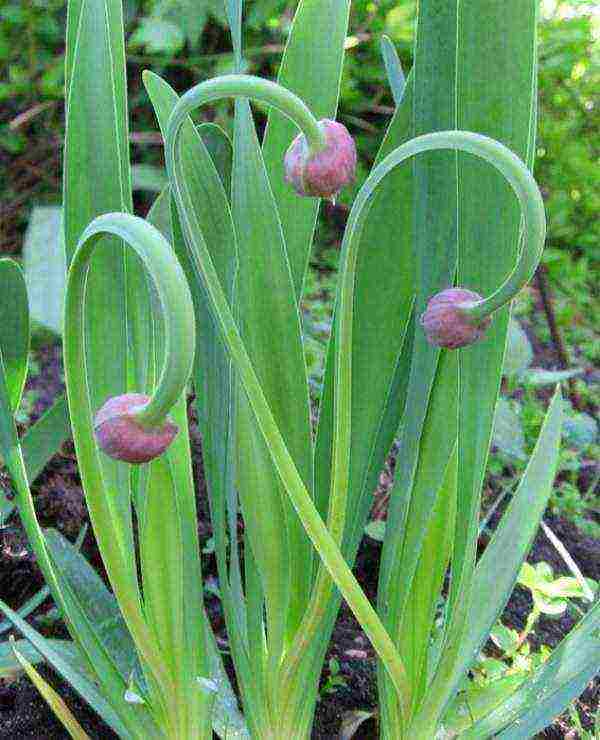
The leaves of this variety are also similar to garlic, in addition, they have a similar spicy pungent aroma. The feather of a slime onion grows quickly, the variety has a high yield. Not afraid of cold weather, can be cultivated in a cool room.
Chives
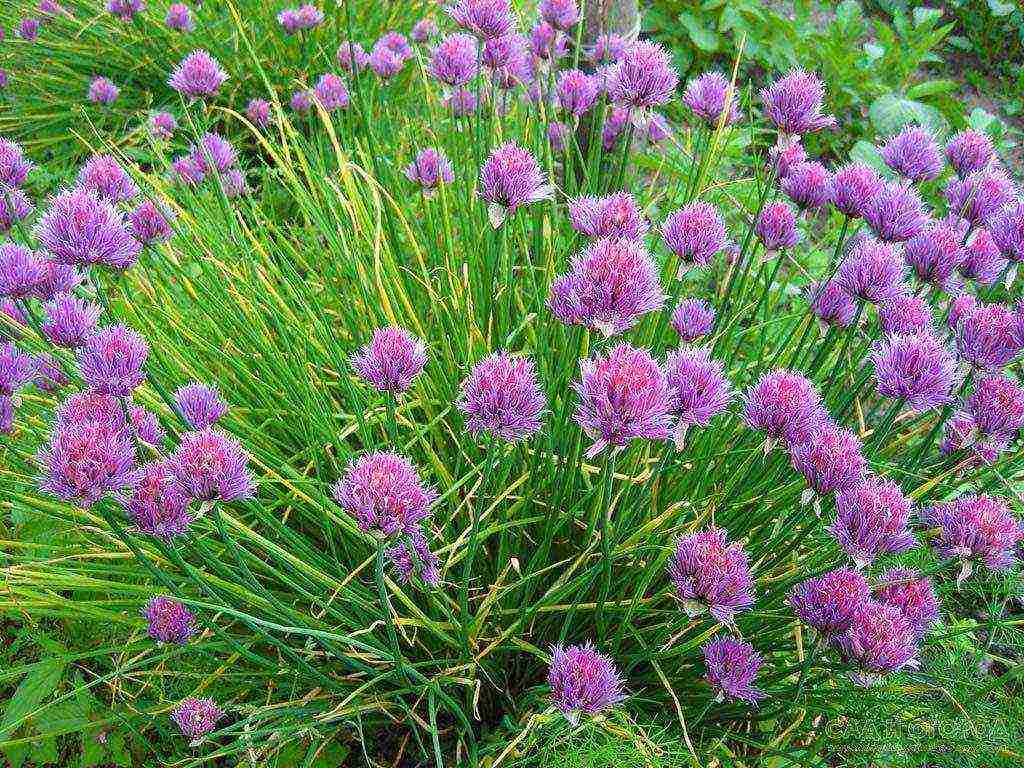
It turns out a very long feather - about half a meter: fragrant and having a long shelf life. Moreover, throughout the entire storage period, the onion aroma and its taste do not disappear anywhere. This is important if you need to transport the crop.
Multi-tiered
The variety is also called Canadian or Egyptian. It is extremely unpretentious, does not need special care: the feather will grow, even if planted and forgotten. It can also grow at low temperatures.
Shallot
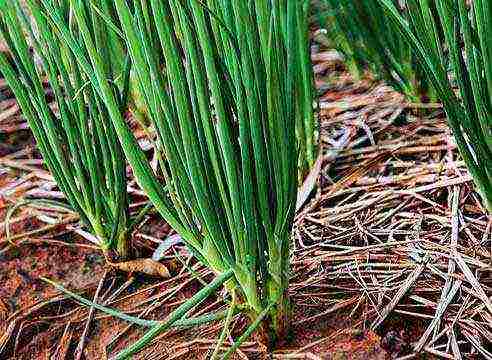
A very famous and productive variety, excellent for home cultivation. Shallots have excellent taste and can be stored for a long time. During storage, the taste and juiciness of the feather are not lost.In addition, the variety is unpretentious, and caring for it is simple.
As for the varieties of onions, which are best suited for growing at home on a feather:
- Rostov;
- Bessonovsky;
- Black Prince;
- Amber;
- Arzamassky.
These varieties are resistant to fungus, fruitful, store well and for a long time, give dense feathers of the correct shape.
Growing onions on a feather is not a very difficult task, any novice gardener can handle it. Subject to the basic conditions of growing and care, you can enjoy healthy fortified greens all year round. Thus, you protect yourself from diseases and viruses, add mouth-watering spicy notes of fresh herbs to your diet.

Foreword
Growing onions at home is available to absolutely everyone - it is a fairly simple process that does not require knowledge and experience. One has only to try, and you can enjoy delicious and healthy green onion feathers throughout the year, and completely free of charge.
What types of onions can be grown on a windowsill?
In addition to the well-known onions at home, you can grow chives, shallots, slugs and multi-tiered onions. Now we will look at how to grow onions at home and what you need to consider when choosing one or another variety.
- Shallots are popular for producing nearly twice as many feathers as onions and growing about a week earlier. The only feature of this species is the obligatory cutting 30-35 days after planting. If you forget about this, there is a great risk of losing your harvest. In addition, it is advisable to plant shallots no earlier than mid-February, otherwise the plant will germinate very slowly. The bulb you just cut the feathers from can be reused: cut it across, plant it again and re-harvest after a short time.
- The advantage of chives is that arrows of this type grow several times faster than onions - they will be ready for consumption literally a week after planting. After cutting, the arrows grow back within two weeks.
- The onion is well known. Its main advantage is its high growth rate. True, the feather coarsens over time, and therefore you need to cut it off in a maximum of a month.
- Multi-tiered onions yield more yields than onions, while having very delicate feathers that are ready for cutting on average 25 days after planting.
- The main difference between slime onions and other species is that the leaves of this variety remain juicy and tender throughout the growing season. Feathers are cut at a height of up to 25 cm.
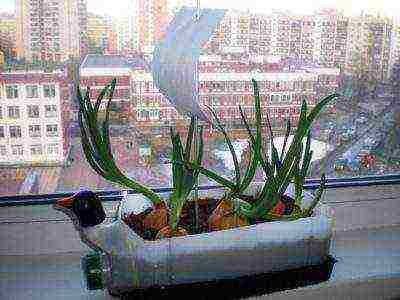
Instructions for growing onions on a windowsill
The most effective and simple way to grow onions at home is the method of forcing on a feather (through sprouting a root crop). It is better to take the bulbs of the same size (no more than 3 cm), they must be healthy and strong, without damage. We place the selected root vegetables in a container with warm water (up to 40 degrees) and put them near the radiator for a day.
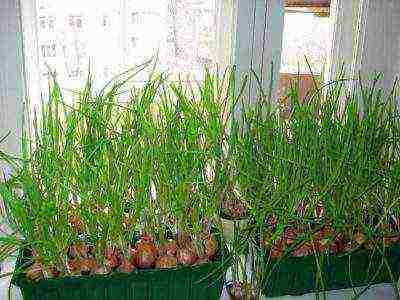
After that, examine the bulbs again, remove the top layer of husk and cut off the upper part by 1.5 cm.For growing, take any wooden box or plastic container up to 10 cm deep.It is best to prepare several containers so that you can grow the plant by conveyor methods - in In this case, you will not need to wait for the next batch of onions to sprout.

Use ordinary garden soil or substrate (fine gravel, sand or expanded clay) as a soil for planting. The substrate is washed twice before use. The first time - in a hot solution of potassium permanganate, the second - in running clean water. We fill the container with soil to a height of 4 cm. Lower the prepared roots into the soil every 2 cm, trying to keep them in an upright position. Do not deeply bury the roots in the ground so that they do not rot.
How to care for onions after planting - advice from gardeners
To grow a good harvest, you need to properly care for the seedlings after planting. So, the container with plantings must be placed in a warm place (the temperature must exceed +25 ° C). When the first stems appear, transfer the container to a windowsill. In this case, it is advisable to choose windows facing south or southwest. If there is not enough sunlight for the plants, try illuminating containers with seedlings with fluorescent lamps.
Only in the case of normal lighting will green feathers be able to accumulate useful trace elements, acquiring a rich aroma and taste.
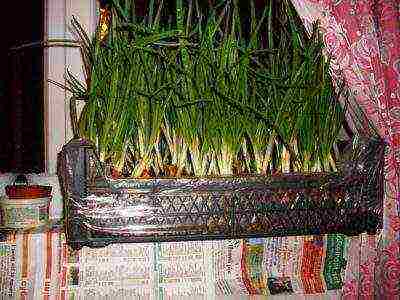
Water the planted root crops 3 times a week with exceptionally warm water. The main thing is that the water is constantly just below the surface of the soil, the soil should not dry out, because during the growth period, onions need a lot of water. Do not cut off the first arrows that have grown, this may slow down the growth of green mass. It is advisable to cut off the feathers 20-25 days after planting, while the extreme arrows are first cut off and only then the central ones. In order for the green mass to grow constantly, the interval between planting onions in boxes should be 1.5 weeks.
Growing onions in water - the original way
There is another way to grow onions on your windowsill or balcony - to use not soil, but water for planting. True, this method is quite laborious and requires certain skills. To grow plants in this way, take large and already sprouted root crops (from 4 cm or more) and several deep containers. In order for the roots to grow and not rot, they must be placed in the selected container so that only the lower part of the bulb with regrown roots is in the water.
To keep the root vegetable in this position, use cardboard with a cut-out hole - cover the glass with the structure and place the onion in the hole. Thanks to this, the root crop will confidently hold in the required position. The bulb is kept in a glass of water for 3 to 5 days, after which the container is moved to the windowsill.
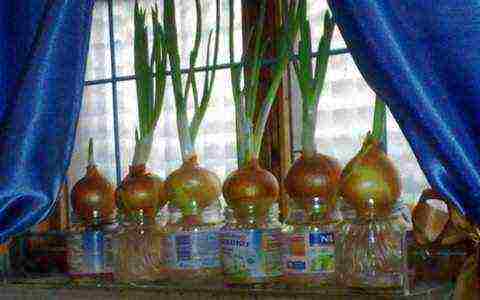
Before the roots form, the water in the glass or plate must be changed twice a day, when the feathers begin to grow - once a day. In this case, it is necessary to rinse the roots and dishes themselves under a stream of clean water. By the way, it is advisable to take water for growing bulbs either bottled or settled for a day.
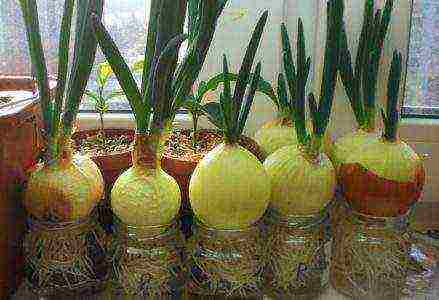
The temperature in the room where the containers with onions will be located should not exceed 22 ° C - otherwise, the onion arrows will be thin and faded. A similar temperature should be when growing radishes at home. Feathers that have grown above 20 cm are cut off, the bulbs themselves are thrown away - they are not suitable for replanting. By the way, it is undesirable to fertilize onions - for normal growth it will have enough sunlight and water. Well, now you know how to plant onions at home and how to grow them so that you can enjoy healthy foods all winter in a row. We hope our tips will help you with this.

When snow is falling outside the window and fluffy snowdrifts lie, it is so nice to see fresh greens on the table! In addition, in winter, natural vitamins are especially needed by our body. And the first helper in the fight against colds or flu is green onions. Phytoncides secreted by onions disinfect the room, destroying bacteria, viruses and fungi.
Smart solutions
Its healing properties help to cope with vitamin deficiency and spring fatigue, increase immunity and improve digestion. Green onion feathers will not only serve as a bright decoration for dishes, but will also have a beneficial effect on the body.
Although green onions can be bought in the supermarket both winter and summer, they are not comparable to those grown on your own windowsill. Firstly, by planting green onions at home, you can pick the required number of feathers for cooking at any time, and secondly, you will be sure that the greens were grown without the use of any harmful substances and chemicals.
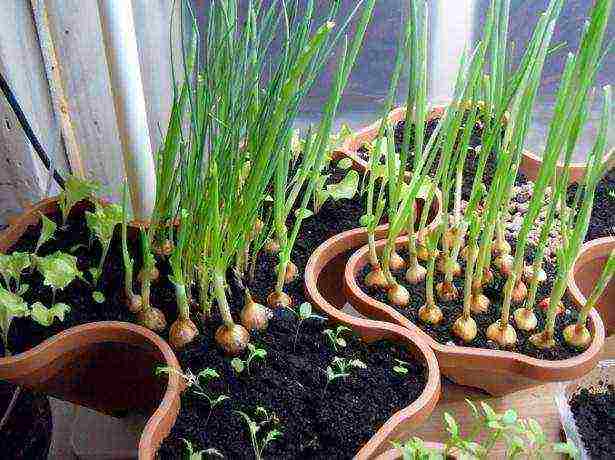
By planting green onions at home, you can pluck the required number of feathers at any time for cooking.
Growing onions at home may seem affordable to any child - stuck a bulb in the ground in a flower pot and watch how green feathers appear. However, if you decide to get serious about the matter and eventually collect a rich harvest of not only greens, but also the bulbs themselves, you will need to take into account a number of basic rules and nuances.
Video about growing green onions at home
Instructions on how to grow green onions at home
In winter, you can get greenery from the bulbs by forcing them onto a feather, that is, by germinating the root crops themselves. For this, onions are usually used, which you grew in your garden or bought in the store. Multi-primordial varieties are optimal (Timiryazevsky, Spassky, Strigunovsky, Arzamassky, Pograsky, Soyuz). The bulbs should be approximately the same diameter - about 2 cm, not damaged or diseased.
Place the calibrated bulbs in a container with hot water (+40 degrees) and put them on the central heating battery for a day. After soaking, a layer of brown husk can be removed to ensure the quality of the selected root crops and to remove the damaged layer, if any. Before planting, the top of the bulbs is cut off by one and a half centimeters.
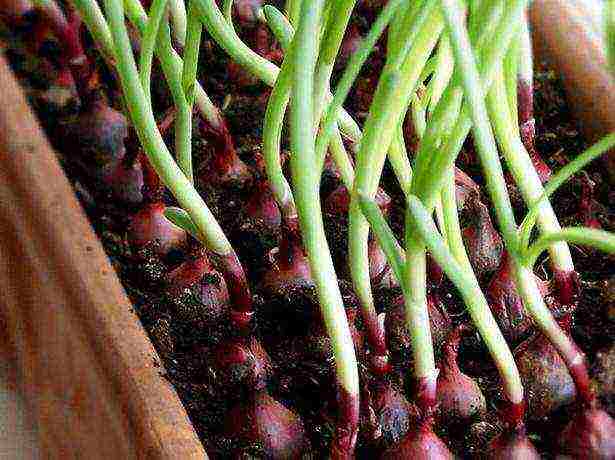
In winter, you can get greenery from the bulbs by forcing on a feather.
Prepare the soil in the container
To sprout onions at home, you can use any boxes, bowls, containers or pallets with a depth of 7 cm or more.It is best to prepare two containers so that you can grow green onions in a conveyor way - then you do not have to wait for the next portion of onion feathers to sprout.
As a soil, you can use land or substrate: fine expanded clay, fine gravel, sand. The substrate should be pre-washed with a hot concentrated solution of potassium permanganate and running water. Fill the boxes with soil 3-4 cm, if you chose a substrate, fill it with water so that it covers the surface by 1 cm. Dip the prepared bulbs into the ground every two centimeters, keeping them upright. It is not necessary to deepen the onion too much, only the roots should be in the water, otherwise the bulbs will rot.
Further care of greens 
Water the planted bulbs every other day with warm water
The container is placed in a warm place for a week, where the temperature does not drop below +25 degrees. When feathers 1-2 cm high appear on the bulbs, you should transfer the box to the windowsill. Windows that face southwest, south and southeast are ideal. If there is not enough sunlight, you can additionally illuminate the containers with fluorescent lamps. Only in the presence of sufficient light will green onion feathers accumulate useful substances and acquire a rich taste.
Water the planted bulbs every other day with warm water. Make sure that the water is constantly at a level just below the surface of the substrate, and the soil does not dry out.
The first green feathers should not be cut, otherwise further growth of greenery will stop. Cutting is done three weeks after planting the onion, and it is better to cut off the outermost feathers first, since the feather grows from the middle. In order for the greens to grow continuously, the interval between planting in different boxes should be 10-12 days.
Video about growing green onions
Growing green onions in water
There is another popular way to grow onions at home without using potting soil. The bulbs are processed as described above and stacked tightly in an upright position on a shallow tray. Water is poured into the pan so that it covers the bulbs by a quarter. As the water level decreases, you will need to refill it. In about two weeks you will have fresh green feathers ready to eat.
The greens do not need additional feeding, since it takes all the nutrients during growth from the bulbs. But to accelerate the regrowth of feathers, you can add water with wood ash dissolved in it (10 l 50 g).
Rate the article:
(5 votes, average: 3.2 out of 5)
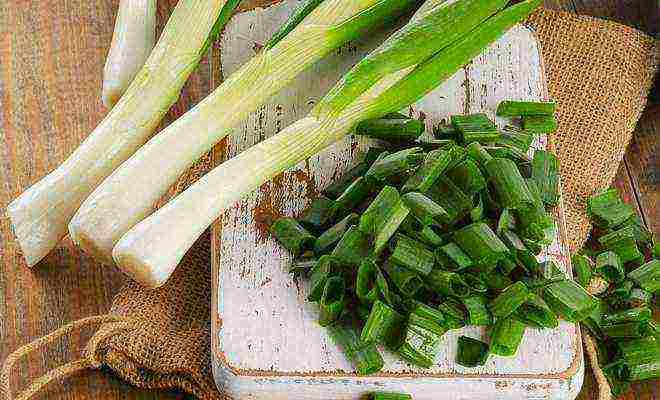
Why does every person need to grow onions in the house, even if he has not yet acquired a dacha? Only in this way you will always have your favorite green plant at hand, without chemicals and impurities.
Green onions are very “grateful” greens for growing at home. He does not need a special soil composition, nor a temperature level - enough good lighting and moderate heat. That is why green onions are successfully grown all year round on window sills and balconies of apartments, even in the center of huge cities.
To learn how to grow green onions in an apartment, you should explore the most popular ways to grow them.
Growing a feather from an old bulb
This is an old and proven method that gives 100% results and is very beneficial from an economic point of view. It often happens that a turnip bought for future use begins to deteriorate in a warm apartment, becomes soft and germinates. It is no longer suitable for food, but it can become an excellent "supplier" of healthy greens.
How to grow green onions from an onion to get as much fresh feathers as possible? There are two ways - to put the onion on a container of water, as in the days of our grandmothers, or to plant it in the ground. Each method has its own advantages and disadvantages.
Growing green onions "hydroponically"
This is a very simple and the cheapest way. They use "junk" onions, which are not suitable for food, that is, in fact, green onions are obtained free of charge. If not for the distillation, the sprouted bulbs would definitely go to the trash can. Water is also not purchased on purpose, and almost any container for planting can be used.
A feature of the method is also the fact that such a receipt of green onions can become a decorative element of your kitchen.

Water in a hydroponic system needs to be grown every day.
If you choose different colored or transparent bottles as containers for water, then the composition of the bulbs "sitting" on them with a bright bunch of fresh green feathers will look very modern and attractive.
For planting the bulbs on the water, you can also use special containers for water distillation of flowering bulbous plants. They are small glass "cones" of various shapes with a narrow neck, expanding upward and forming a special container for the bulb.
The key to growing green onions is in the form of these forcing tools. If you are interested in how to grow green onions at home from a bulb without losing planting material, remember that the bottom of the "turnip" should not be submerged in water. If this is allowed, the old onion will rot very quickly and die. If the water just touches the bottom, the onion will give good healthy roots that will sink into the water and nourish the greens. The bulb itself will remain dry and give a maximum of feathers.

When the roots appear, you need to change the water every 3-5 days.
To avoid "blooming" of water in a warm room, you can add 1 - 2 crystals of potassium permanganate to it, until the liquid turns pale pink. Potassium permanganate does not harm the quality of the feather, on the contrary, feeding with manganese contributes to the formation of healthier and healthier greens. To extend the life of one bulb, it is better not to cut the feather, but break off one at a time as it ripens.
Green onions from bulbs in soil
Old sprouted bulbs can also be planted in the ground, but this method is more costly, since it will require the acquisition of special land for seedlings, drainage and planting containers.
The most rational way is to plant onions by bridge, that is, close to each other. This will hold many bulbs in a small, flat container. They do not need to be completely immersed in the ground, maximum by a third. Successful cultivation will require good drainage so that water does not stagnate.
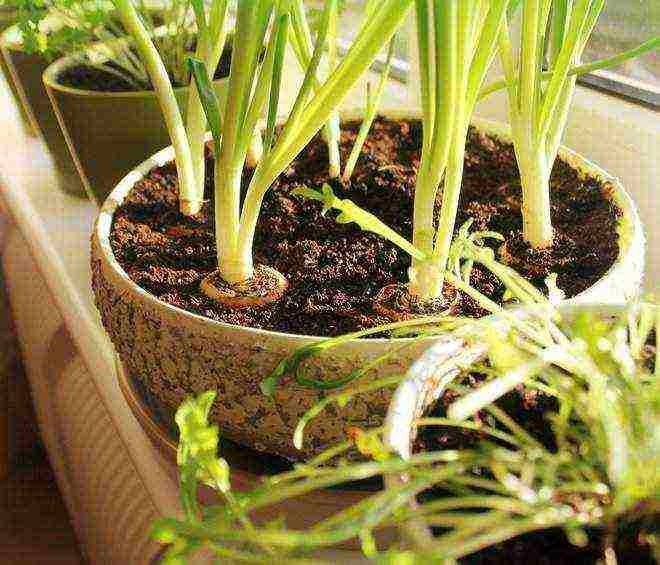
Sowing is carried out to a depth of 2-3 cm (deeper on light soils, shallower on heavy soils)
Caring for such plantings is exactly the same as for bulbs on the water. The advantage of this method is space saving. If you have a small window sill, it is more profitable to put a tray with a dozen bulbs on it than five separate vessels.
Growing a feather from onion sets
How to grow green onions on the balcony? Very simple. You will need onion sets. These are small bulbs obtained from seeds last year. They are planted in the spring in the ground for growing a full-fledged turnip. At home, you can get a lot of high quality green onions from the set.
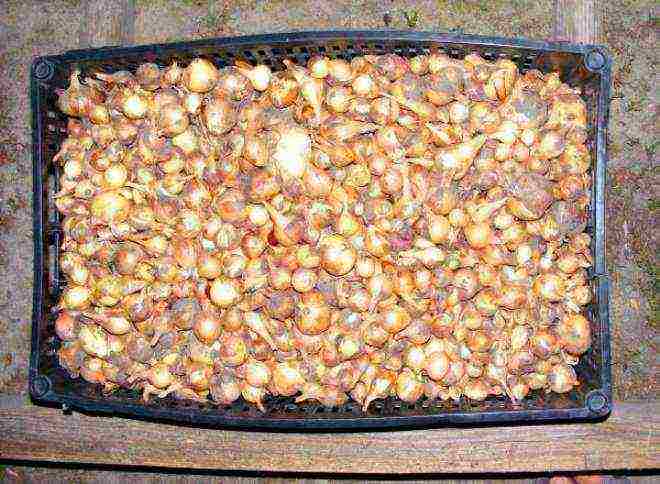
Before planting, treat the heated seed with a growth stimulant.
For planting, high-quality material without signs of disease is selected. Bulbs should be medium in size, even, smooth and shiny. It is best if they are covered with a uniform and sufficiently dense husk - such a set will last longer than "naked". In addition, high-quality seedlings are the least susceptible to disease and produce a lot of greenery. Check that there are no black spots on the onion, and that there are no traces of mold in the form of bluish or gray lumps on the roots and base.
Such bulbs are chosen and immediately thrown away, as otherwise they will infect the entire "colony" and your green onion plantation will die without having time to give a crop. A soft bow is also thrown out, when pressed on which, its surface noticeably bends under the finger. Most likely, this onion has already begun to rot inside.
Pickling and warming up the set
This procedure is carried out in the same way and with the same purpose as when planting seedlings in open ground. The high temperature awakens the growth point, and all the onions begin to actively sprout and develop together. Etching kills possible pathogens, as well as existing pest egg clutches.
Onions are usually heated in water with a temperature of no higher than 50 degrees. You can combine heat treatment with etching and stimulation by adding potassium permanganate, aloe juice or succinic acid to the water. The most common and effective method of combating diseases and pests is a dark purple solution of potassium permanganate.
Onions for growing in the house are not treated with chemicals.
Preparation of soil and containers
To disinfect the soil and containers in which green onions will grow, they must be carefully prepared and processed.
Plastic trays are washed with hot water if new. Used containers can be cleaned with baking soda or chlorine disinfectant. After such treatment, it must be rinsed under running water and filled with cool water overnight. This is to ensure that the remaining detergent dissolves and rinses out completely.
Wooden containers are cleaned of old soil, washed and scalded with boiling water.
Soil cultivation is equally important. It can contain eggs and larvae of pests, various pathogens and fungal spores. Most often, the following methods of soil disinfection are used:
· Steaming;
· Warming up;
· Treatment with a disinfectant solution.
For steaming, you need a container with a good drain and boiling water. The earth is watered with water that has just boiled, trying to evenly process the entire volume. Excess water is allowed to drain freely, and the soil is thoroughly dried. With this exposure, most spores and viruses, as well as pests with a soft shell, die. Those with a hard shell or shell of eggs may not be harmed.

To warm up the soil, the temperature in the oven should be 85-100 ° C
Heating is most often done in the oven.The earth is scattered in a thin layer on a baking sheet and placed in a well-heated oven for 20 - 30 minutes. With this treatment, 99% of pests and sources of diseases die.
Treatment with a disinfectant solution is extremely simple and consists in abundant watering with a bright crimson solution of potassium permanganate, followed by drying the soil. It is important to ensure a good drainage of the water. With this treatment, fungal diseases are well destroyed.
Planting seeding in the ground
If the soil and containers are prepared, and the sevok is processed, you can start planting. Sows are planted in the same way as large old bulbs. This is a bridge method in which the bulbs are planted in rows as close to each other as possible. To save space, especially if you do not know how to grow green onions at home on a small windowsill, the bulbs are slightly offset from each other. So they will fit much more in a relatively small area.
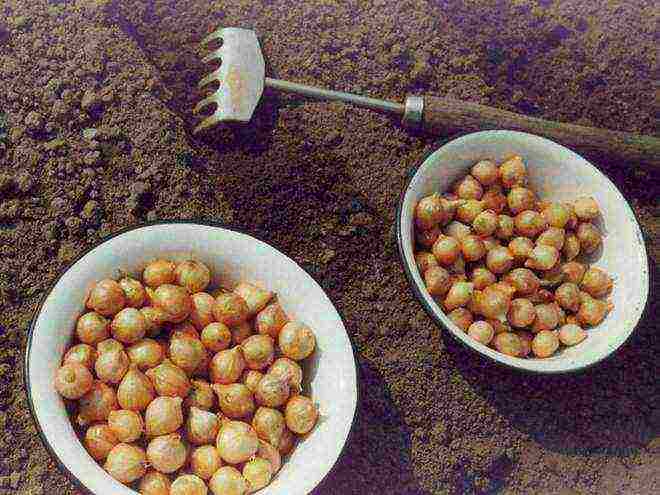
Sowing is planted in rows with a distance of 8-10 cm from each other, the distance between the rows is no more than 4 cm.
The planted set is carefully watered and placed in a bright and warm place. Until the onion sprouts, it does not need a lot of light, high temperature is much more important for rapid germination. It must be at least 22-25˚С. When growth begins, the bulb trays can be moved to a windowsill or balcony. You need to choose the most illuminated area - in the dark, the greens will stretch out, will be pale and stunted.
The easiest way to grow green onions is on closed balconies and loggias. There is enough warmth and a lot of light. Multiple trays can be accommodated by custom-sized wall shelves. A wide window sill or a table attached to it will also help with placement.
The balcony and the kitchen with the grown onions must be periodically ventilated, choosing the warmest non-frosty days for this. If the plants are on the windowsill, they are removed away from the open window during airing.
Planting care
Since the onion grows in a fairly short time, it simply does not have time to completely deplete the soil. No feeding is needed for home greens, as they may contain too many toxic chemicals due to the use of fertilizers.
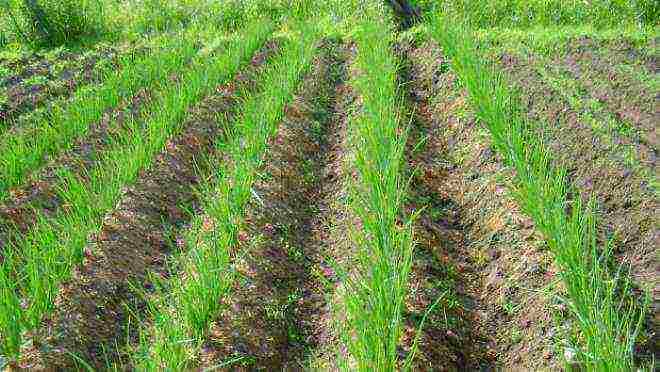
To protect plants, spray the onions with Volaton, Zolon or Acrobat
All care consists in regular moderate moisture and timely cleaning of the green feather. When it becomes clear that the strength of the bulb is exhausted and there will be no more harvest, the old "spent" seedlings are thrown away, the land is either re-prepared or replaced with fresh ones. The growing process can be started over.
Mixed landings
Onions grow well "in the company" of other greens. If you have free space or don't need a lot of green onions, but have an interest in getting a variety of greens, you can do mixed plantings.
To do this, seeds of the desired spicy herbs are sown in one container - dill, parsley, watercress, cilantro and many others. The choice of herbs depends only on the preferences of the owner. You can plant a basil bush or some celery plants. Since many plants germinate for a very long time, for example, dill and parsley can "sit" in the ground for up to 40 days or even more, the seeds are germinated before sowing. Sevok can be planted after areas with parsley or dill are outlined. This way you can get a good harvest of greenery almost at the same time.

Onions can grow next to beets, lettuce, strawberries, spinach, cucumbers, radishes, carrots.
***
Such a micro-garden on a windowsill or balcony will require a little more attention, but the return will increase several times. Almost the entire cold winter, you can delight your loved ones with delicious soups, main courses and salads, abundantly sprinkled with fragrant fresh herbs, which are also grown by your own hands.
